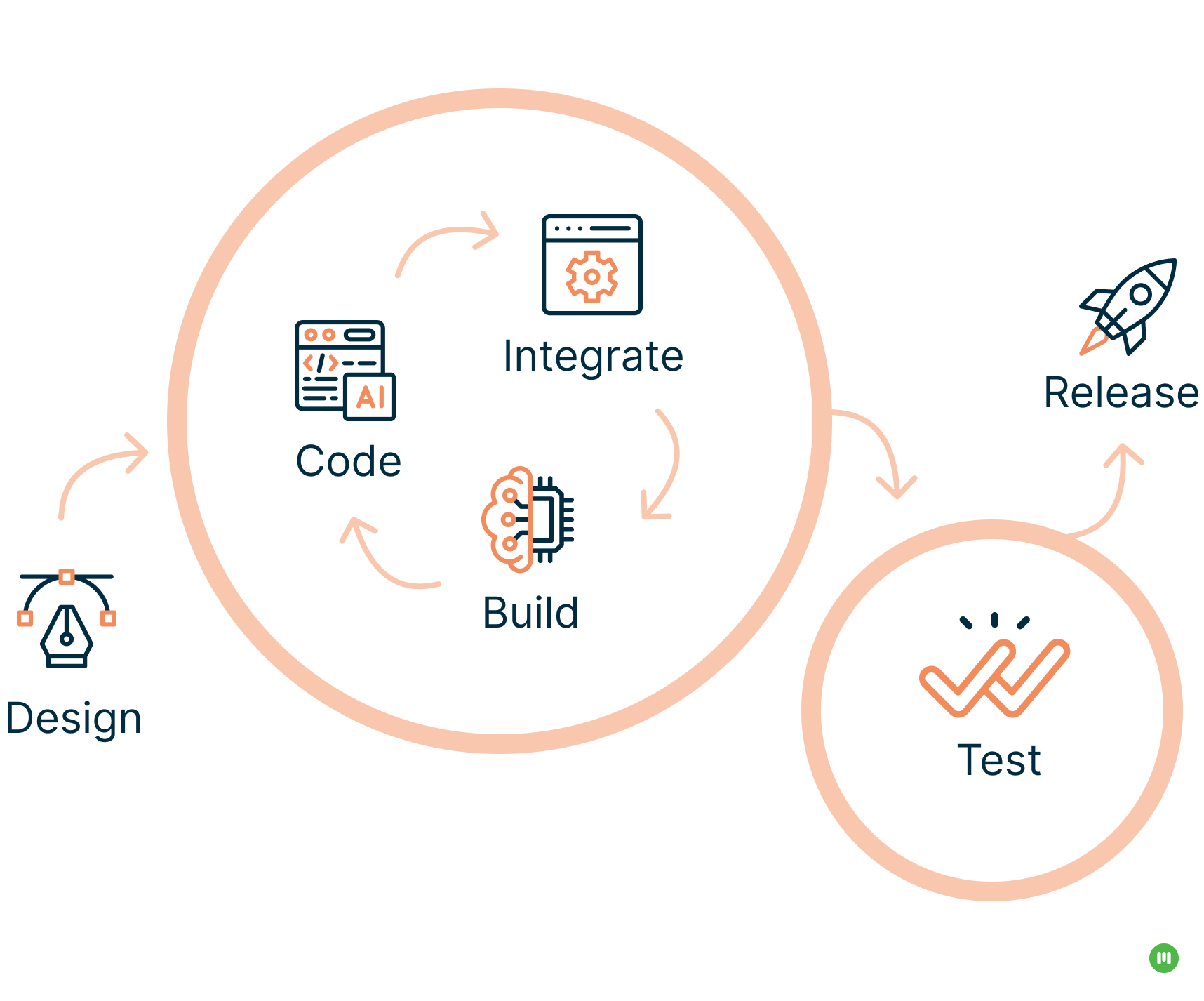Augmented Engineering: Where AI meets human expertise

Leveraging AI to drastically improve team efficiency
For over 25 years in digital transformation consulting, we’ve prioritized creating an efficient handoff between UX and engineering teams. We pride ourselves on building human-centered digital products as fast as possible that look and function as intended. Over the past decade, like many digital creative firms, we streamlined our design-to-code process to the point where engineering has been able to kick off just a day or two after designs are approved.
That all changed this past year when we experimented with adding AI tools to our internal workflows. Now, not only do we begin the engineering process within a few days, but we can complete the vast majority of front-end coding almost as quickly. Over several select projects of varying sizes, we’ve slashed hours of manual coding from our process—not only reducing time-to-market by as much as 60% but also freeing up our engineers’ time to focus on more complex, strategic work. Research from Github similarly found that developers are 55% faster with the use of AI co-pilots.
We’ve all heard the hype surrounding AI—but the truth is, AI’s tremendous potential to eliminate repetitive tasks can’t be overstated. AI is a force multiplier. But just like you wouldn’t want to give a racecar to a bad driver, the practitioners driving powerful AI tools must be capable and committed to meeting responsible tech standards.
So it’s our perspective that organizations can’t rely on algorithms alone. That’s why our latest offering is called “Augmented Engineering”—a design-to-dev workflow that empowers senior engineers with machine learning tools. The best part for our clients? Augmented Engineering shifts more of their budget to things like validation testing, feature-rich releases, and optimization. In other words, better outcomes are delivered significantly faster.
As we move into this era of AI-powered engineering, I’m excited to take our mission of designing, building, and marketing digital experiences that people love to the next level. Here’s how we see AI reshaping digital product development.
Traditional engineering vs. Augmented Engineering
In a traditional engineering process, a UX team will create design elements using a collaborative tool like Figma. The designers will then hand off the Figma files to a development team, who are tasked with turning the Figma designs into working code. Historically, this process requires front-end engineers to look at the Figma designs and then build the component library based on atomizing the components of the design framework, in our case typically React. So they'll build React components, and then stitch them together into pages or, in the case of an app or software product, experiences. Often, there are a bunch of iterations as the programmers go through rounds of design updates.
These changes are often technically simple yet detail-oriented, like tweaking the number of pixels on the radius of a button, or ensuring the right attributes are in place to support accessibility standards.
With Augmented Engineering, senior engineers at Modus use a proven recipe that combines Figma design specifications, enterprise-grade AI tools, specific AI prompting strategies, and years of practical expertise to very quickly generate production-ready code that not only meets design requirements exactly, but also meets rigorous security (OWASP Top Ten defect-free) and accessibility (WCAG AA) requirements.
AI speeds up coding by automating repetitive tasks, iterating rapidly, and generating functional code blocks. Additionally, as the AI trains on an organization’s design system, brand and content guidelines, and component library, it gets smarter over time. Turnaround times only get faster.
Augmented Engineering for additional engineering and DevOps tasks
Beyond front-end code generation, AI systems are driving tangible outcomes for development teams at digital platform consulting firms like ours. More nimble DevOps cycles result in competitive advantages for our clients.

Automated testing and QA
AI automates the generation of test cases, allowing us to identify bugs earlier, and ensuring code reliability. By streamlining testing and performing regression analysis, it improves overall software quality while minimizing manual testing efforts. This means faster and more reliable testing, reduced time spent in QA, and improvement in the overall stability of the product.
CI/CD and integration
AI can rapidly generate scripts to build deployment pipelines, ensuring smooth launches through continuous integration and ongoing monitoring. This reduces deployment risks and minimizes downtime, allowing engineers to focus on delivering value quickly. The result? Seamless integration and faster deployments, allowing more frequent rollout of features and updates.
Bug detection and debugging
By grouping similar errors and identifying patterns, AI tools reduce the noise and help engineers prioritize the most critical issues. Additionally, AI can offer recommendations for fixes based on past issues or common solutions, speeding up the debugging process and allowing engineers to focus on implementing robust solutions more efficiently. This saves engineers hours spent on bug fixes, leading to fewer disruptions and smoother project delivery.
Documentation automation
Rather than having a set of documentation that describes how a product was originally supposed to work, AI tools automatically generate documentation based on what the code actually does, eliminating errors and the need for manual documentation updates. This ensures that all technical documentation remains accurate and up-to-date throughout the project lifecycle—a major time-saver that results in clear, accurate project details without the overhead.
Our Augmented Engineering roadmap
Where is this all going? As we are moving along the AI maturity curve, we’re experimenting with AI-powered tools internally across disciplines and throughout the design-to-development lifecycle. We’re rapidly prototyping new concepts, tracking results and performance, and deepening our understanding of where AI fits in the journey from idea to successful launch.

